Twigs and Branches - April 2023
A web of present and past events
The Wildflower Garden in May
Even though the onset of spring has been tardy (again), everything catches up in the month of May.

- If you missed the bloom of the snow trilliums in April, there are eight other trilliums to see in May. We wrote about those a year ago in The Fringed Gentian™ - revisit the article here.
- Warblers pass through the Garden in May. We published an article about them last spring. It has been amended by adding photos of all twenty six spring warblers that have been seen at the Wildflower Garden - check it out here.
- Interested in spring programs at the Garden - visit the Garden’s website for a listing.
- Since spring is late, you may still get a look at the five earliest bloomers in the Garden. Review them here.
- If you are in the woodland on the right day you may get to see in bloom one of the solitary spring ephemerals - the Fumewort. (Photo below) The time is as variable as the spring weather, but it is usually early and it does not bloom for many days. Look for it just north of the patio water fountain on the path down the hill toward the wetland.
- The upland area comes into glory in summer but during May you should be able to easily spot the Golden Alexander and look for the Field Pussytoes and Shooting Star.
- Here is a photo reference to an entire cast of spring blooming plants - both early and late spring.
Early spring blooming plants
Late spring blooming plants.
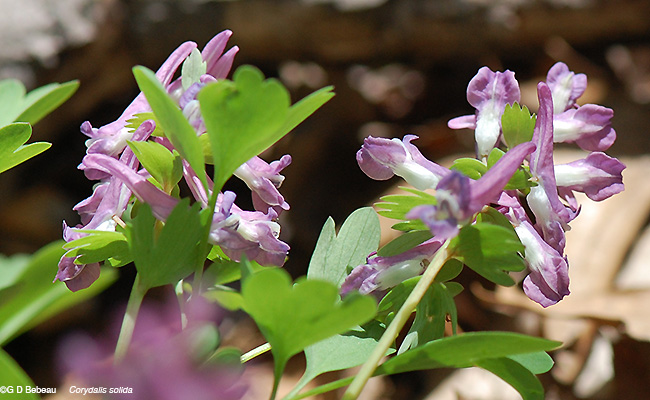
When you do get to the Garden, check out the new boundary fence arrangement in the upland and the new roof on the Gardener’s shed near the restrooms.
Where Does the "Spring Green" Come From?

Spring is the season of forty shades of green and some of the most varied and delicate are those of spring leaves which, by summer all seem to be a much darker and more evenly colored shade of green.
Leaf color is determined by which wavelengths of light are absorbed or reflected. Spring variation is caused by the little energy units in each leaf cell that do the job of photosynthesis. These are called chloroplasts and they absorb more blue and red than green light and in the spring there are fewer of them in the cells to do the absorbing, so more blue and red pass through and give us more colors.
As the leaf matures the number of chloroplasts in the cells are more dense and the cell walls are more dense, thus absorbing more blue and red, leaving more and more green to be passed through and seen by us.
Checkout this short article from Inside Science.
Below: The Quaking Aspen provides an example of the difference in color of a spring leaf (left) and a mature summer leaf (right).

A New Invasive
Catch it before it spreads
Another plant was added to the Restricted Noxious Weed list in Minnesota this January 1. It is known as Lesser Celandine (Ficaria verna). Ficaria is a new designation; most references will still list it as Ranunculus ficaria.
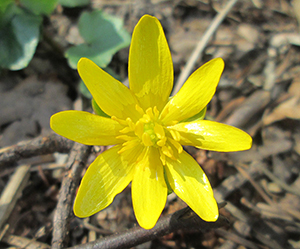
Flora of North America states that “In North America, Ranunculus ficaria seems to be expanding its range rapidly in areas with cool mesic climates.”
The Minnesota DNR states: “It is a relatively new invader to the state. It is a great example of a plant to watch for in the spring. Early spring detection allows for quicker management response and targeted treatments before other desirable plants begin to develop and flourish.”
“Lesser celandine has a very short lifecycle, growing as soon as the snow melts and dying back to its underground roots by June. iNaturalist photos from an infestation in Saint Paul show that its bloom time varies greatly in the state. One post shares blooming lesser celandine on March 26, while another shares it is blooming on May 6. Environmental conditions influence blooming times, but being prepared earlier in the spring will allow for greater management success. It is also important to familiarize yourself with native plants that look like invaders such as lesser celandine.”
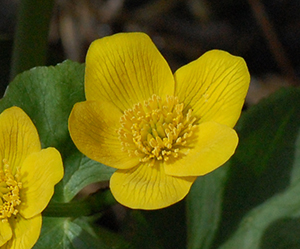
“A plant that you may find blooming at the exact same time as lesser celandine is the native marsh marigold, Caltha palustris. Marsh marigold is generally larger than lesser celandine, and it grows in bunches. Lesser celandine is low-growing and will form dense mats. Marsh marigold has only five petals on its showy yellow flowers, and lesser celandine has 7-11 petals. Lesser celandine also has a glossy shine to it, while marsh marigold does not. If you’re still not sure what you’re looking at, look below the flower petals. Lesser celandine will have three green sepals, marsh marigold doesn’t.”
“Because of lesser celandine’s short growth window, there is little time to find and control new infestations. Its main method of spread is vegetative by underground tuberous roots and aerial bulbils at the nodes. This makes it difficult to control effectively. Control and monitoring efforts will need to be repeated for several years.”
The leaves of the lesser celandine and marsh marigold are quite similar and the two plants are found in similar areas. Photo below by AnRo0002.

Eloise Butler's Last 10 Days
Remembering her after 90 years
April 10th was the 90th anniversary of the death of Eloise Butler.
In the March Twigs and Branches we noted what Eloise had been doing to find a successor to herself as Curator of the Wild Flower Garden so that what she had created could be carried forward without the Garden being destroyed.
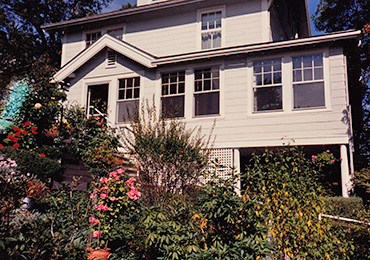
When she left Malden on March 31 she had been unsuccessful in that endeavor. She returned to her Minneapolis lodgings at the J. W. Babcock house on April 3 1933. As he usually did, Mr. Babcock notified her Garden helper, Lloyd Teeuwen, that she had returned but Eloise wanted to rest a few days after the long train ride from the east coast as she was “not used to walking a lot yet.”
Several days later Lloyd came to the house and carted down to the Garden office the assortment of books from her library at Babcocks that she wanted in the Garden and also the Garden’s tools which were kept in the Babcock carriage house over the winter. Then they took the first walk of the year through the Garden where Eloise inspected all the areas to see what was what. She walked very slowly so Lloyd kept behind her to not outrun her. Eloise remarked how enthusiastic she was to be back outside where she could do something because in Boston nobody wanted to do anything.
The only work she noted in her Garden Log was planting Swamp Candles on April 8 on the north side of the Mallard Pool.

On the morning of April 10 Lloyd came over to Babcocks to see if she wanted help getting down to the Garden. It had rained during the night and the steep path from the Babcocks down to the north meadow and the Garden was wet and muddy. Eloise thought she should wait awhile, so Lloyd went down to the Garden where he was dealing with some brush. A few hours later he returned to the Babcock house to find Eloise lying on a couch in the entry way with a doctor taking care of her.
Eloise had attempted the hill to the Garden herself but did not get far. Mrs. Babcock told Teeuwen that Eloise had gone out but was only gone a short time when she returned. "She'd come in and Mrs. Babcock said ‘She said she didn't feel too good.’” The doctor then told them that she was still breathing but he did not think she had long to live and 10 minutes later at 2:15 PM he said that “she was gone.”
What happened thereafter - finding her successor, the funeral, the memorial ceremony, the memorial boulder - is all documented in our short history of Eloise on our website and in The Wild Gardener by Martha Hellander.
This material has been extracted from a long interview with Lloyd Teeuwen, May 4, 1988 by Martha Hellander in the presence of Gardener Cary George. Complete audio tape and partial transcript in the Martha Crone Collection, Minnesota Historical Society. Text in quotes are Teeuwen's. Lloyd passed away on June 16, 1992. He was the only person living in 1988 who had known Miss Butler and worked for her in the Garden. He was 19 at the time of Miss Butler's death and had helped her in the Garden for six years.
Below: The J. W. Babcock house at 227 Xerxes Aveune seen from the rear (west side) showing the steep hillside descending toward the north meadow. When Mr and Mrs Babcock had both passed away, their children sold the entire property which included a carriage house and 3 cabins to the Park Board and from that point forward, the land on the west side of Xerxes became part of Theodore Wirth Park.
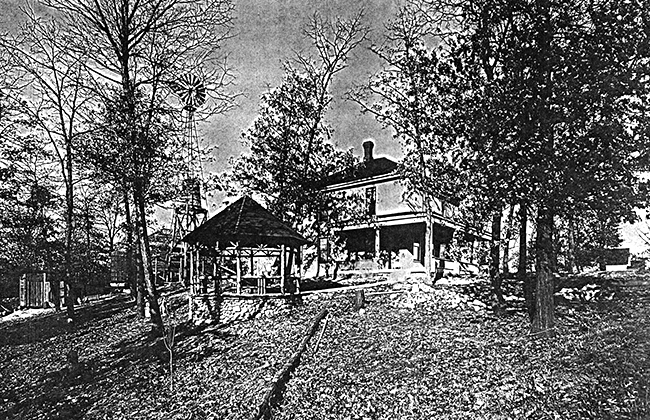
Previous articles
All selections published in 2023